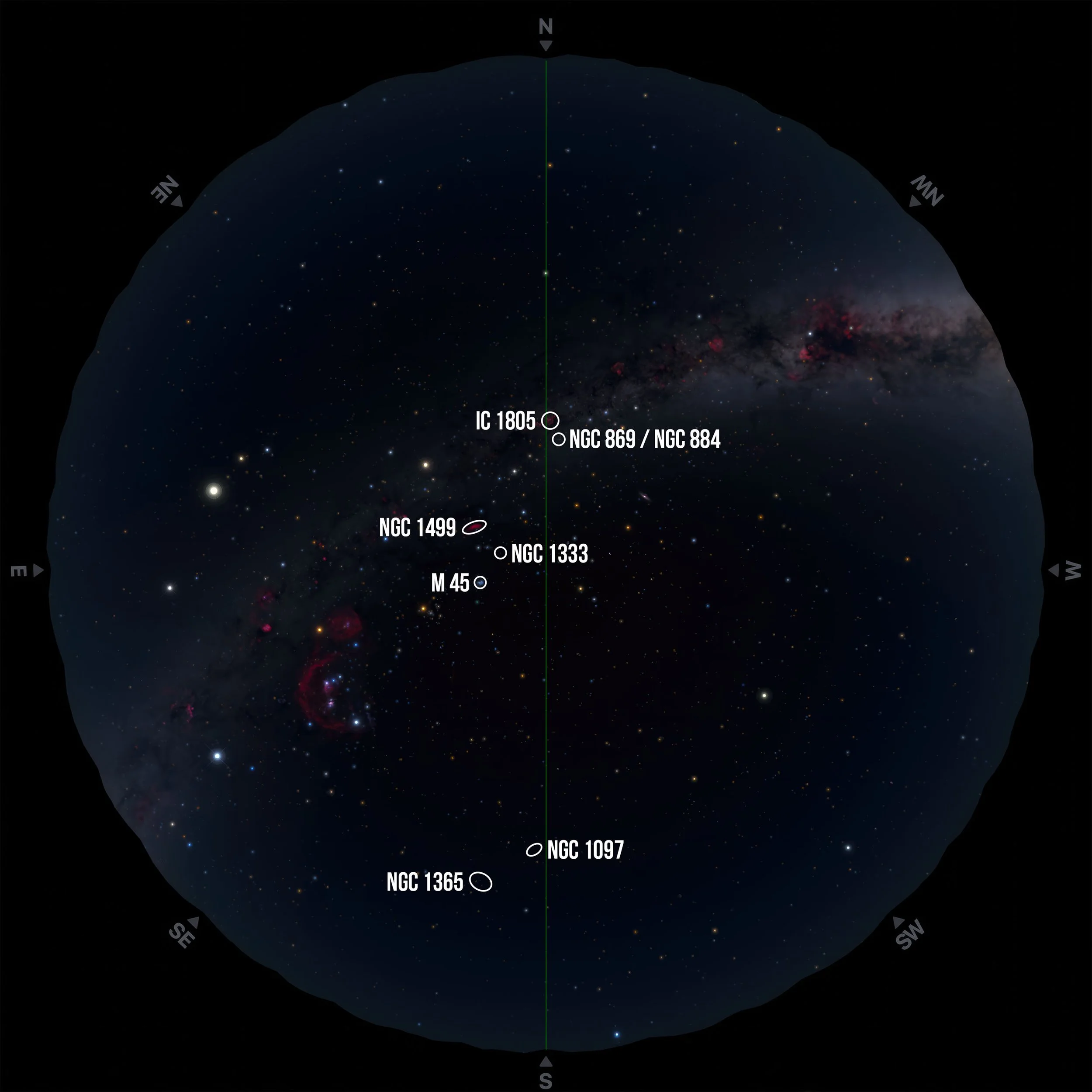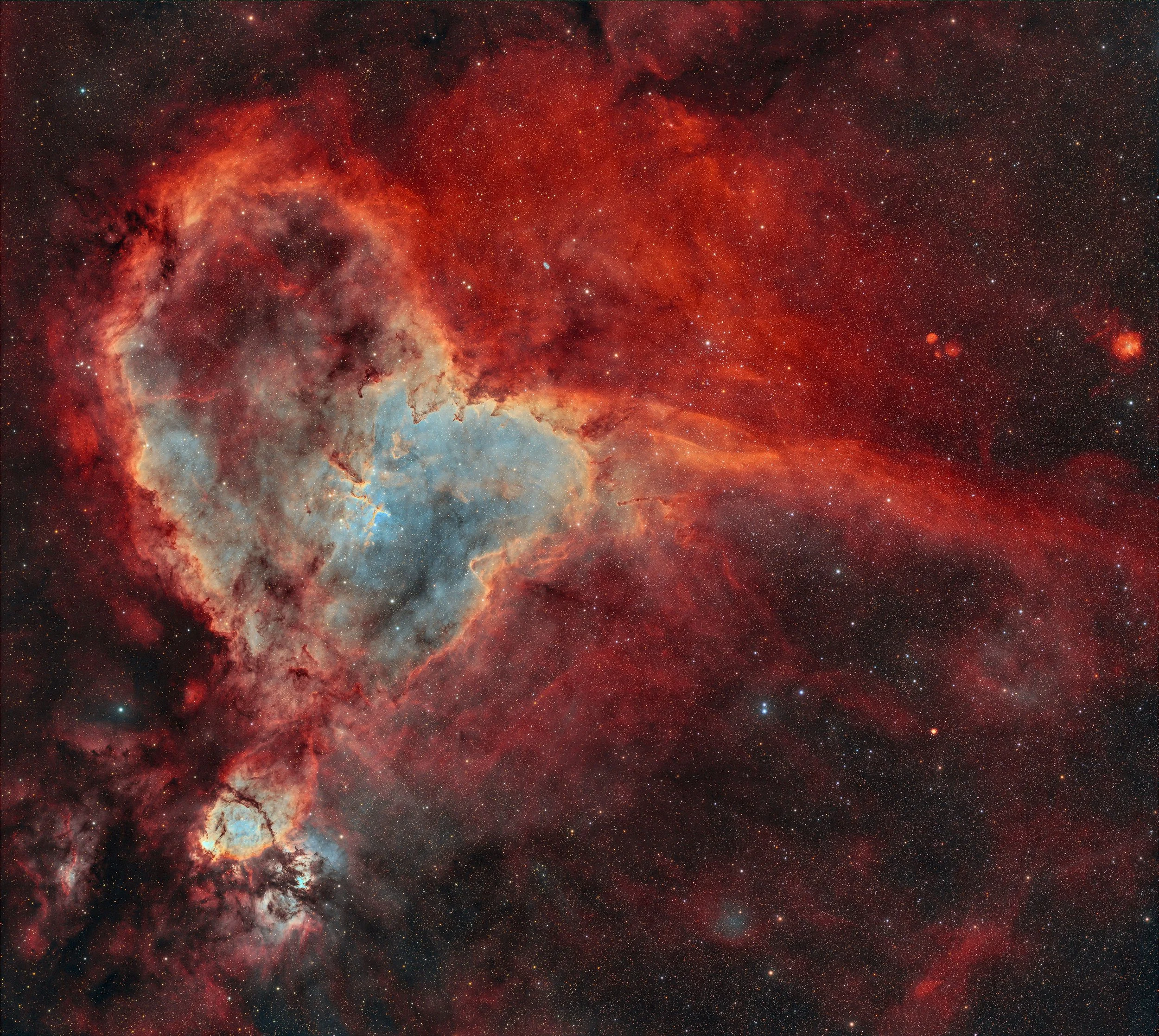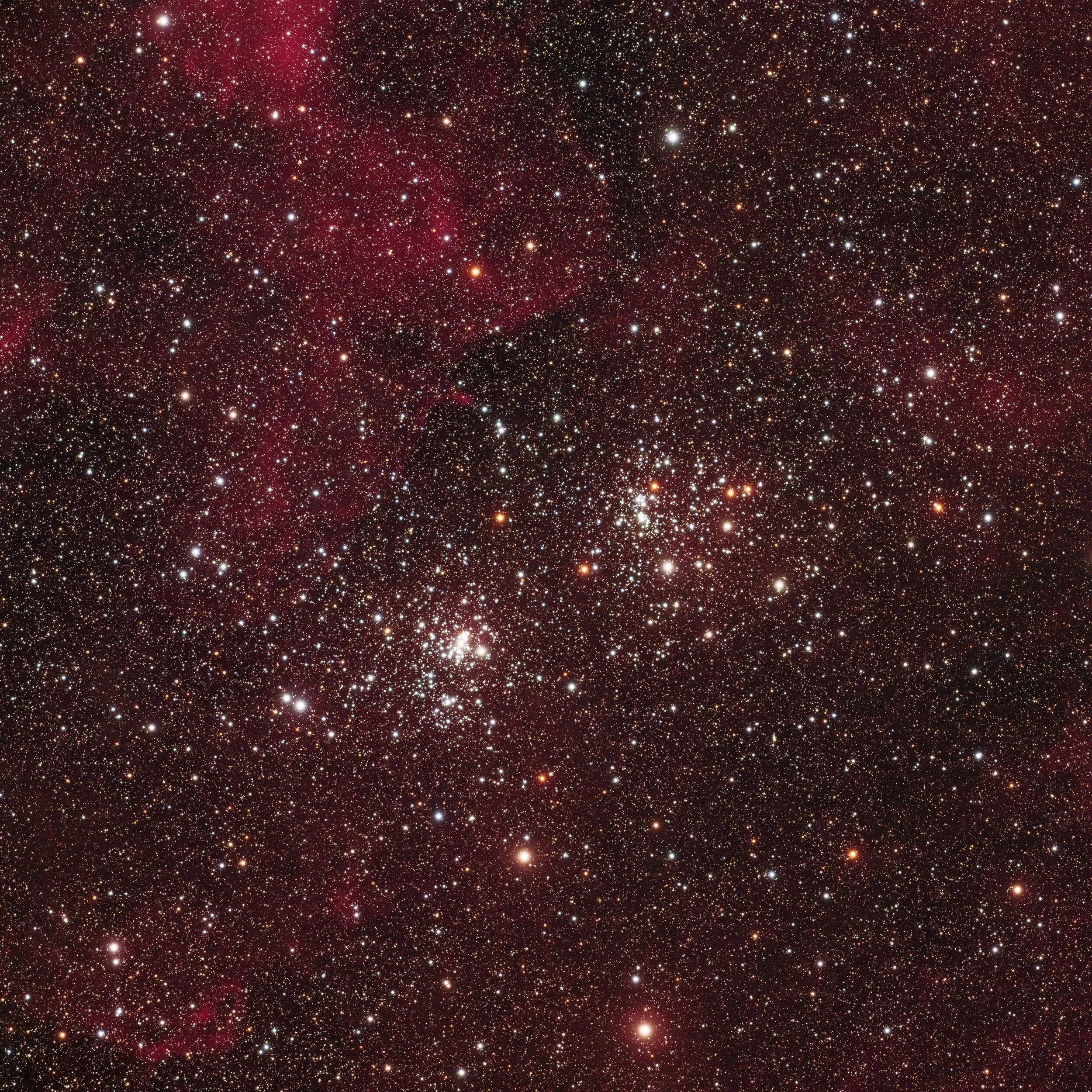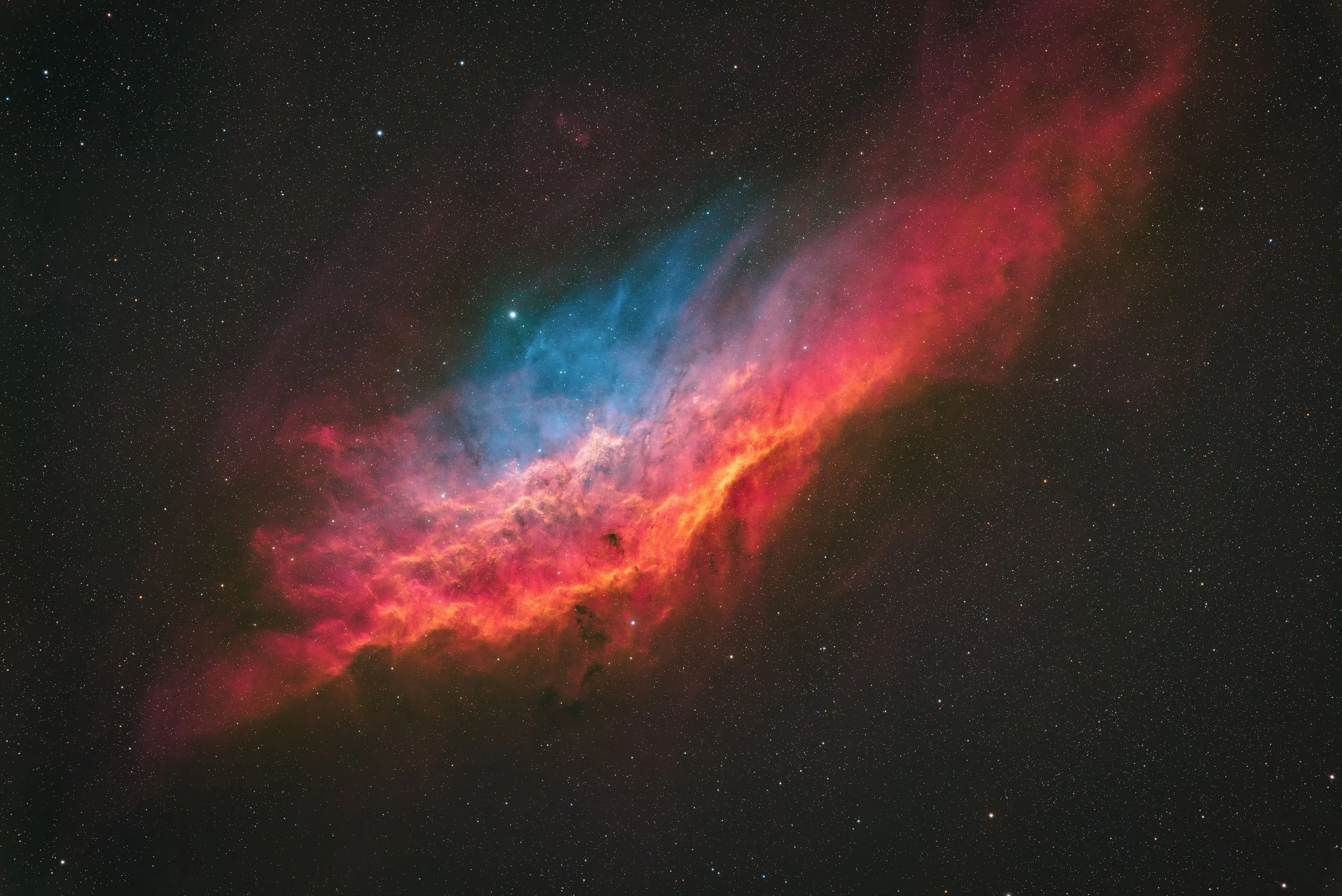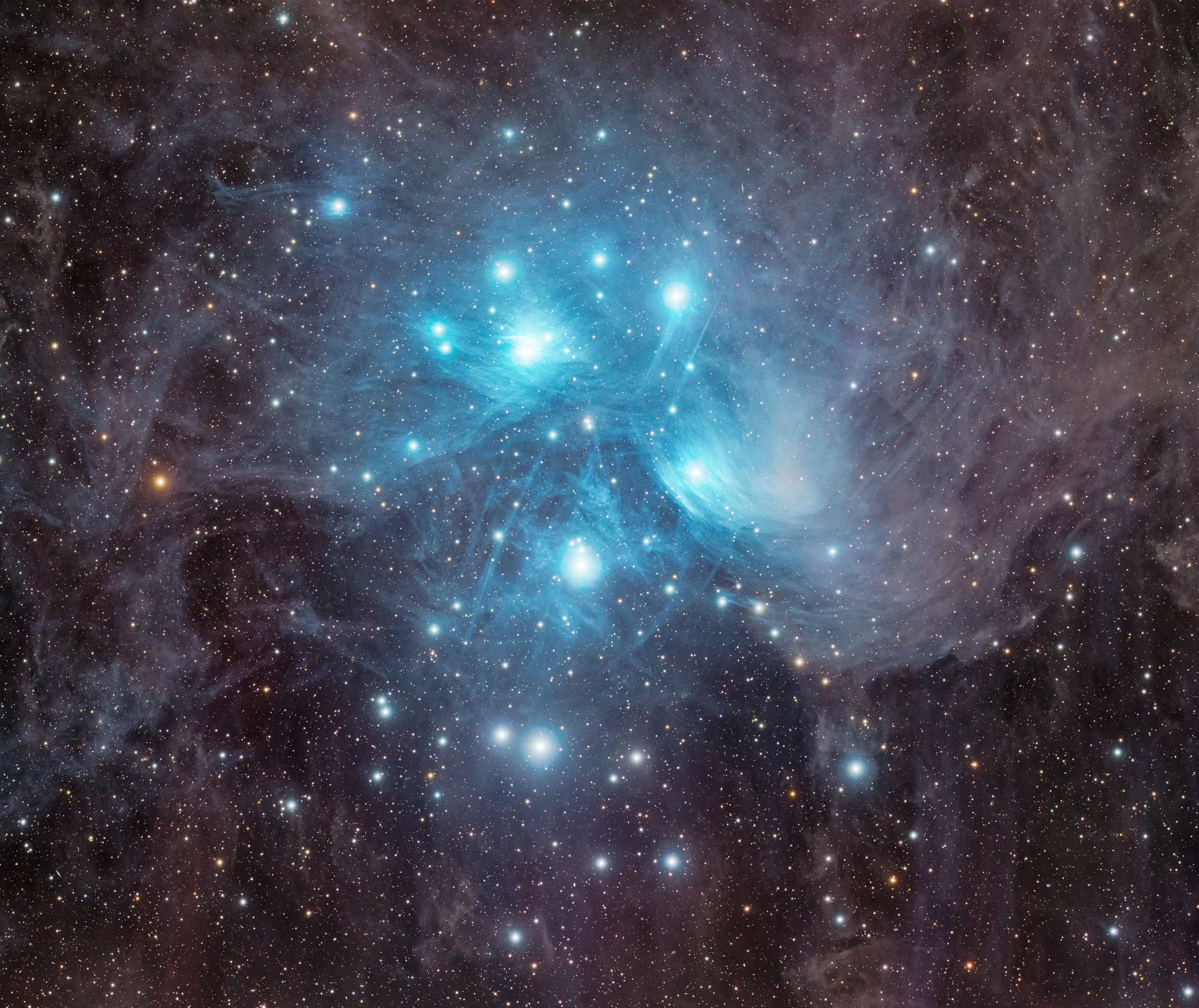
NOVEMBER 2025
Between Seasons of Light
November sits between two chapters of the Milky Way.
In the north, the glowing heart of our galaxy sinks below the horizon, giving way to a quieter sky — one rich in dust, reflection, and subtle colour. The nights grow quickly longer, and with them come the delicate textures of Perseus and Taurus: the shimmering veil of the Pleiades, the soft glow of the California Nebula, and the deep, tangled clouds around the Heart Nebula.
Far to the south, the balance tips the other way. The nights grow shorter as spring leans toward summer, and galaxies like NGC 1097 and NGC 1365 climb high, their spiralling arms echoing the structure of the Milky Way itself.
This is a month of transition — when brightness gives way to depth, and the sky reveals its quieter wonders to those who take the time to look.
The November Night Sky at a Glance
Northern Hemisphere Sky – Midnight at New Moon (at +30° latitude)
The bright Pleiades (M45) now stand high overhead — a beacon of the changing season. Nearby, the California Nebula (NGC 1499) stretches faintly through Perseus, while the Heart Nebula (IC 1805) and Double Cluster remain prominent to the north. Together, they reveal a sky rich in dust and reflection rather than emission, full of cool blues and subtle reds.
Image from the app Sky Guide
Southern Hemisphere Sky – Midnight at New Moon (at -30° latitude)
November’s midnight sky belongs to the galaxies of Fornax and Eridanus. The grand barred spirals NGC 1097 and NGC 1365 stand near their highest point, their sweeping arms bright in long exposures. Around them, the Fornax Cluster offers a field of ellipticals and lenticulars — a deep-sky feast for longer focal lengths.
Image from the app Sky Guide
At midnight on the new Moon, these targets stand close to the meridian—their highest point in the sky. That makes them visible all night long and ideally positioned for imaging. The charts below give a general view of where to find them in the northern and southern skies.
Deep-Sky Targets in November
November brings a change in tone to the night sky. In the north, the bright Pleiades (M45) take center stage, joined by the California Nebula (NGC 1499) and the Heart Nebula (IC 1805) glowing faintly through rich clouds of interstellar dust. Above them, the Double Cluster and NGC 1333 reveal a quieter side of the Milky Way — a tapestry of reflection, dust, and newborn stars.
In the south, the focus shifts beyond our galaxy. The barred spirals NGC 1097 and NGC 1365 stand near their highest point, their sweeping arms and bright cores marking some of the season’s most rewarding galaxy fields.
Below, you’ll find a visual overview and key info for each target.
For full framing advice, exposure tips, and filtration suggestions, download this month’s Cosmic Astrophotography Planner (CAP) as a free PDF using the button below.
IC 1805 – The Heart Nebula
Constellation: Cassiopeia | Distance: ~7,500 light-years | Apparent Size: ~2° × 1.5° | Apparent Magnitude: ~6.5
The Heart Nebula (IC 1805) is a vast emission region in Cassiopeia, glowing red with ionised hydrogen and shaped by powerful stellar winds from the open cluster Melotte 15 at its core. The nebula spans over 200 light-years across, forming one of the most recognisable H II regions in the Perseus Arm of our galaxy. Within its intricate filaments lie pillars of gas and dust sculpted by radiation from newly formed stars, echoing the same processes that once shaped our own Sun’s birthplace.
Best for: Widefield imaging. A focal length of 135–300 mm captures the full heart-shaped structure along with neighbouring regions such as the Soul Nebula (IC 1848). Longer focal lengths around 500–800 mm resolve the dense central region of Melotte 15, revealing fine details in the dark lanes. Narrowband filters (H-alpha, S II, O III) are highly effective, enhancing contrast and bringing out the complex interplay of emission and dust that defines this iconic target.
Image by Cosmic Captures
NGC 869 & NGC 884 (h and χ Persei) – The Double Cluster
Constellation: Perseus | Distance: ~7,500 light-years | Apparent Size: ~1° combined | Apparent Magnitude: ~4.3
The Double Cluster — NGC 869 and NGC 884 — is one of the most beautiful and recognisable star cluster pairings in the night sky. Situated between Perseus and Cassiopeia, these two young open clusters formed from the same giant molecular cloud roughly 13 million years ago and remain gravitationally bound. Each contains several hundred hot, blue-white stars, creating a rich, glittering field that stands out even in small telescopes or binoculars.
Long exposures reveal a faint background glow of hydrogen-alpha emission surrounding the region — a subtle trace of the larger star-forming complex that includes the Heart and Soul Nebulae. Capturing this faint emission requires dedicated H-alpha imaging and long integration times, but adds striking depth to wide-field compositions of Perseus.
Best for: Widefield or moderate focal-length imaging. A focal length of 200–300 mm frames both clusters together, while 500–800 mm allows close-up compositions highlighting their individual colours and density. The Double Cluster shines beautifully in broadband RGB, with narrowband data adding only a faint hint of surrounding hydrogen glow.
Image by Cosmic Captures
NGC 1499 – The California Nebula
Constellation: Perseus | Distance: ~1,000 light-years | Apparent Size: ~2.5° × 0.5° | Apparent Magnitude: ~5.0
The California Nebula (NGC 1499) is a vast emission nebula glowing softly in hydrogen-alpha light, its elongated shape reminiscent of the U.S. state that gives it its name. It lies about 1,000 light-years away in Perseus, near the bright star Menkib (ξ Persei) — a hot O-type star whose intense ultraviolet radiation is responsible for ionizing the surrounding gas. The nebula spans more than 70 light-years, making it one of the largest and most photogenic hydrogen regions in the northern sky.
Because its glow is dominated by H-alpha, the California Nebula often appears as a monochrome streak of deep red in most images. However, it also emits in sulfur-II (S-II) and faintly in oxygen-III (O-III). These reveal themselves only through long, patient integrations but capturing these emissions with narrowband techniques allows astrophotographers to create a far more colourful and dynamic portrait of this vast region.
Best for: Widefield imaging. A focal length of 85–200 mm frames the entire nebula, while longer lenses up to ~400 mm isolate its central filaments and the region around Menkib. The California Nebula is a rewarding narrowband target, ideal for both DSLR and dedicated astro cameras — particularly under light-polluted skies.
Cosmic Captures and Telescope.live image data edited by Cosmic Captures
NGC 1333 – Reflection Nebula in Perseus
Constellation: Perseus | Distance: ~1,000 light-years | Apparent Size: ~6′ × 3′ | Apparent Magnitude: ~5.6
The Reflection Nebula NGC 1333 is a small but active star-forming region on the western edge of the Perseus Molecular Cloud, one of the closest stellar nurseries to Earth. Its soft blue glow comes from starlight reflected by surrounding dust, rather than hydrogen emission — giving it a very different appearance from nebulae like the Heart or California. Within its dusty folds, over a hundred young stars are taking shape, their jets and outflows carving dark lanes and filamentary structures through the cloud.
For astrophotographers, NGC 1333 is a challenge of subtlety and patience. Long exposures reveal a tangle of brown dust and blue reflection, set against a dark background rich in faint molecular cloud detail. It’s a perfect target for those who enjoy uncovering the quieter, more intricate side of the night sky.
Best for: Medium-to-long focal lengths (400–800 mm) under dark skies. Wider fields (100–200 mm) show its context within the Perseus Molecular Cloud, alongside nearby dark nebulae such as Barnard 205. Because it’s a reflection nebula, broadband RGB imaging works best — narrowband filters are not effective.
Image by Cosmic Captures
M45 – The Pleiades
Constellation: Taurus | Distance: ~440 light-years | Apparent Size: ~2° | Apparent Magnitude: 1.6
The Pleiades (M45), also known as the Seven Sisters, is one of the most famous and easily recognisable star clusters in the night sky. This nearby open cluster contains several hundred stars, though only a handful are visible to the naked eye. The brightest members — including Alcyone, Maia, Electra, and Merope — illuminate the surrounding dust, creating a delicate blue reflection nebula that gives the cluster its iconic glow.
Unlike emission nebulae, the Pleiades’ haze is not leftover gas from star formation but an unrelated interstellar dust cloud that the cluster is currently passing through. This chance encounter produces the striking reflection pattern seen in deep astrophotography.
Best for: Widefield imaging. A focal length of 85–200 mm frames the entire cluster with room to spare, while 300–600 mm reveals the intricate wisps of reflection dust surrounding the brightest stars. Broadband RGB imaging captures its natural blue tones, while long integration times bring out the faint cirrus-like structures that make the Pleiades one of the most captivating widefield targets of the season.
Image by Cosmic Captures
NGC 1097 – Barred Spiral Galaxy in Fornax
Constellation: Fornax | Distance: ~45 million light-years | Apparent Size: ~9.3′ × 6.3′ | Apparent Magnitude: 9.5
The barred spiral galaxy NGC 1097 is one of the most photogenic galaxies in the southern sky. Located about 45 million light-years away, it features a bright central bar crossed by faint spiral arms rich in dust lanes and star-forming regions. A small companion galaxy (NGC 1097A) orbits nearby, connected by a faint tidal bridge — evidence of their ongoing gravitational interaction.
At its core lies a supermassive black hole surrounded by a compact ring of intense star formation, often resolved in professional observations. In deep amateur images, the galaxy’s extended stellar streams become visible — ghostly traces of older galactic mergers.
Best for: Medium-to-long focal lengths (800–1500 mm) under dark southern skies. A moderate integration time reveals the bar and spiral arms clearly, while deep exposures bring out the tidal features. Broadband LRGB imaging works beautifully, and adding H-alpha data enhances the reddish star-forming knots scattered along the spiral arms.
Telescope.live image data edited by Cosmic Captures
NGC 1365 – The Great Barred Spiral Galaxy
Constellation: Fornax | Distance: ~56 million light-years | Apparent Size: ~11′ × 6′ | Apparent Magnitude: 9.3
The Great Barred Spiral Galaxy (NGC 1365) is one of the most spectacular examples of a barred spiral in the entire sky. Lying around 56 million light-years away in the constellation Fornax, it spans more than 200,000 light-years across — nearly twice the size of the Milky Way. Its majestic spiral arms extend symmetrically from a bright central bar, where a supermassive black hole powers an active galactic nucleus (AGN).
For astrophotographers, NGC 1365 rewards long exposures under dark southern skies. Deep images reveal faint outer extensions of the spiral arms, subtle dust lanes, and hints of background galaxies scattered throughout the field. It’s a prime example of galactic structure and motion on a grand scale, and a highlight of the southern spring sky.
Best for: Long focal lengths (1000–2000 mm) and long integration times. Broadband LRGB imaging captures its true colour balance, while an added H-alpha layer enhances the reddish knots of star formation along the spiral arms. The galaxy’s striking symmetry makes it an ideal centrepiece composition for the southern galaxy season.
Telescope.live image data edited by Cosmic Captures
The main Moon Phases in November 2025
Planning your imaging sessions? The Moon plays a massive role in what we can capture.
Here’s what’s happening this month:
Full Moon
November 5
The Moon reaches full phase on November 5, known as the Beaver Moon — and this year, it’s also a supermoon. Appearing slightly larger and brighter than usual, it occurs just a day after the Moon’s closest approach to Earth.
Last Quarter
November 12
Deep-sky imaging is best in the first half of the night before the Moon rises in the early morning hours.
New Moon
November 20
The darkest skies of the month arrive with the New Moon, ideal for deep-sky imaging.
First Quarter
November 28
Deep-sky imaging is best after midnight.
Also great for capturing lunar surface details with strong shadows along the terminator.
November 2025 MAP
(Moonlight Astrophotography Planner)
Each month, the MAP — or Moonlight Astrophotography Planner — helps you choose the best nights for capturing galaxies, nebulae, and nightscapes. Whether you’re shooting broadband or narrowband, MAP gives you clear guidance based on the Moon phase, so you can match your imaging plans to the sky conditions.
You can download this month’s MAP as a free PDF using the button below. It’s updated monthly to help you make the most of your imaging time, no matter your style or setup.
Leonid Meteor Shower — Peak: November 17–18
The Leonids peak on the night of November 17–18, with near-perfect conditions this year as the Moon remains below the horizon for most of the night. Under dark skies, observers can expect an average of 15–20 meteors per hour, though the rate can vary widely from year to year.
The Leonids are fast, bright meteors — often leaving persistent trains as they burn through the upper atmosphere. They originate from Comet 55P/Tempel–Tuttle, whose debris stream the Earth crosses every November. Roughly every 33 years, this shower produces spectacular meteor storms, though 2025 is expected to be a moderate but steady display.
The next major Leonid outburst is predicted around November 2033, following the parent comet’s 2031 return to the inner Solar System.
Best viewing: After midnight and before dawn, when the radiant in Leo climbs high in the east. Find a dark location, allow your eyes to adjust for at least 20 minutes, and enjoy one of the most historically famous meteor showers of the year.
Orionid radiant @ 3:30 am over the eastern horizon at 30 degrees northern latitude
(Sky Guide App)
Nightscape Opportunities
In the Northern Hemisphere, November marks the quiet transition into the long, cold nights of winter — a gift for nightscape photographers. The Milky Way core now sets early, but the winter constellations rise in full glory: Orion, Taurus, and Gemini climb higher each evening, filling the sky with bright stars and colourful nebulae. This is the ideal time to capture rising Orion’s Belt and the surrounding Barnard’s Loop, or the Pleiades shining amid faint reflection dust.
In the Southern Hemisphere, the Milky Way’s bright center fades, but its elegant outer arms still stretch across the sky in the early evening. As the season turns, constellations like Eridanus, Fornax, and Sculptor take centre stage. The Magellanic Clouds remain well placed for widefield imaging — glowing softly above southern landscapes.
With longer nights in the north and shorter ones in the south, November offers a changing rhythm to skywatching. Use the Moonlight Astrophotography Planner (MAP) to time your sessions for the darkest, clearest windows and make the most of these shifting skies.
Image by Cosmic Captures

